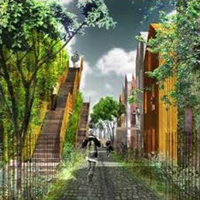Public Private Partnerships for Resilient Communities
Abstract
This article focuses on the role of local institutions in mitigation and adaptation to climate change, considering learning experiences in promoting public-private partnerships in to resilient actions. It does so under the belief that climate impacts will affect disadvantaged social groups and small-communities more disproportionately, and that local institutions centrally influence how different social groups gain access to and are able to use assets and resources. Looking at the increasing awareness that global temperatures will raise, a mentality "Climate-smart" must be adopted by all levels of decision-making. This approach involves the search for synergies between climate change mitigation and adaptation, wherever is possible. As for mitigation, for adaptation we consider similar pre-conditions. Base on this pre-conditions we identify Public Private Partnerships as a challenge possibility to finance decentralized renewable energies and green infrastructure for resilient communities. The article aims to demonstrate two main unclear topics in existing understanding about institutions and climate change responses: the correlation among Public Private Partnerships and participatory process and how it lead to win-win climate responses funding, a learning experience from Sustainable Energy Action Plan - Within the MED Programme project ZeroCO2[1] - and Local Adaptation Plan development – within the LIFE+ project BLUE AP[2].[1] Kyoto Club was partner of the MED Project ZERO CO2 www.medzeroco2.eu
[2] Kyoto Club is partner of the LIFE+ Project BLUE AP Bologna Local Urban Environment Adaptation Plan for Resilient City – www.blueap.eu
Downloads
References
Colucci, A. (2012). Towards resilient cities. Comparing approaches/strategies. Tema. Journal Of Land Use, Mobility And Environment, (5)2, 101-116. doi: http://dx.doi.org/10.6092/1970-9870/921
Galderisi A., Ferrara F.F. (2012). Enhancing urban resilience in face of climate change: a methodological approach TeMA 5 (2), pp. 69-87. doi: http://dx.doi.org/10.6092/1970-9870/936
Agrawal, A., Lemos M. (2007). A Greener Revolution in Making? Environmental Governance in the 21st Century. Environment 49(5): 36-45. Available at: http://www-personal.umich.edu/~arunagra/publications/2007.%20Arun%20Agrawal%20and%20Maria%20Carment%20Lemos.%20%20A%20Greener%20Revolution%20in%20Making.pdf
Agrawal, A. (2008). The Role of Local Institutions in Adaptation to Climate Change. Prepared for the Social Dimensions of Climate Change, Social Development Department. Washington, DC: World Bank. March 5-6. Available at: http://siteresources.worldbank.org/EXTSOCIALDEVELOPMENT/Resources/244362-1164107274725/sdp118.pdf
EEA (European Environmental Agency) (1999). Environmental Indicators: Typology and Overview. Technical Report, Copenhagen: EEA. Available at: http://www.eea.europa.eu/publications/TEC25
Figueira J., Roy B. (2002). Determining the weights of criteria in the ELECTRE type methods with a revised Simos’ procedure. European Journal of Operational Research, 139(2), 317-326. doi: http://dx.doi.org/10.1016/S0377-2217(01)00370-8
Giupponi C., (2007). Decision Support Systems for implementing the European Water Framework Directive: The MULINO approach. Environmental Modelling & Software, 22(2), 248-258. doi:http://dx.doi.org/10.1016/j.envsoft.2005.07.024
Giupponi, C., Sgobbi A., Mysiak J., Camera R., and Fassio A. (2008). NetSyMoD - An Integrated Approach for Water Resources Management. In: Meire, P., M. Coenen, C. Lombardo, M. Robba, and R. Sacile, (ed.), Integrated Water Management, 69-93, Netherlands: Springer. doi:http://dx.doi.org/10.1007/978-1-4020-6552-1_6
IPCC (Intergovernmental Panel on Climate Change) (2007a). Climate Change 2007: The Physical Science Basis. Contribution of Working Group I to the Fourth Assessment Report of the Intergovernmental Panel on Climate Change [Solomon, S., D. Qin, M. Manning, Z. Chen, M. Marquis, K.B. Averyt, M. Tignor and H.L. Miller (eds.) ]. New York: Cambridge University Press. Available at: http://www.ipcc.ch/publications_and_data/publications_ipcc_fourth_assessment_report_wg1_report_the_physical_science_basis.htm
IPCC (Intergovernmental Panel on Climate Change) (2007b). Climate Change 2007: Impacts, Adaptation and Vulnerability. Contribution of Working Group II to the Fourth Assessment Report of the Intergovernmental Panel on Climate Change. [M.L. Parry, O.F. Canziani, J.P. Palutikof, P.J. van der Linden and C.E. Hanson (eds.) ] Cambridge: Cambridge University Press. Available at: https://www.ipcc.ch/publications_and_data/publications_ipcc_fourth_assessment_report_wg2_report_impacts_adaptation_and_vulnerability.htm
IPCC (Intergovernmental Panel on Climate Change) (2012). Managing the Risks of Extreme Events and Disasters to Advance Climate Change Adaptation. A Special Report of Working Groups I and II of the Intergovernmental Panel on Climate Change [Field, C.B., et al (eds.)]. Cambridge University Press, Cambridge, UK, and New York, NY, USA. pp 582. Available at: https://www.ipcc.ch/pdf/special-reports/srex/SREX_Full_Report.pdf
Janssen M.A., Schoon M.L., Ke W., Borner K. (2006). Scholarly networks on resilience, vulnerability, and adaptation within the human dimensions of global change program. Global Environmental Change 16: 240-52.
Kates, R. (2000). Cautionary tales: Adaptation and the global poor. Climatic Change 45 (2000) (1), pp. 5–17. Available at: http://rwkates.org/pdfs/a2000.02.pdf
Kaylen, M. S., Wade J.W., Frank D.B. (1992). Stochastic trend, weather and us corn yield variability. Applied Economics 24 (5): 513-18. doi:http://dx.doi.org/10.1080/00036849200000064
Salat, S. & Bourdic, L. (2012). Systemic Resilience of Complex Urban Systems. Tema. Journal Of Land Use, Mobility And Environment, 5(2), 55-68. doi:http://dx.doi.org/10.6092/1970-9870/918
World Bank (2011). Conflict, Security and Development: World Development Report 2011. Washington D.C., USA. Available at: http://siteresources.worldbank.org/INTWDRS/Resources/WDR2011_Full_Text.pdf
World Bank (2007). CDD in the Context of Conflict-Affected Countries: Challenges and Opportunities. Report N. 36425-GLB. Washington D.C., USA. Available at: http://siteresources.worldbank.org/INTCDD/Resources/CDD_and_Conflict.pdf

Copyright (c) 2015 Tema. Journal of Land Use, Mobility and Environment

This work is licensed under a Creative Commons Attribution 4.0 International License.
Authors who publish in this journal agree to the following:
1. Authors retain the rights to their work and give in to the journal the right of first publication of the work simultaneously licensed under a Creative Commons License - Attribution that allows others to share the work indicating the authorship and the initial publication in this journal.
2. Authors can adhere to other agreements of non-exclusive license for the distribution of the published version of the work (ex. To deposit it in an institutional repository or to publish it in a monography), provided to indicate that the document was first published in this journal.
3. Authors can distribute their work online (ex. In institutional repositories or in their website) prior to and during the submission process, as it can lead to productive exchanges and it can increase the quotations of the published work (See The Effect of Open Access)
